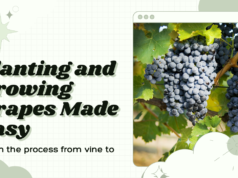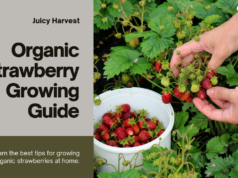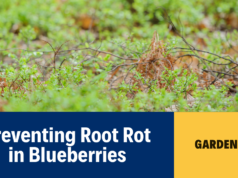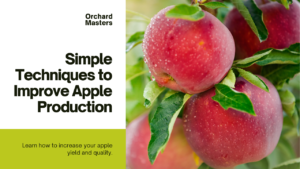
Welcome to our informative guide on improving apple production! If you are an apple tree enthusiast looking to boost your yield and ensure thriving trees, this article is for you. By implementing simple techniques such as pruning, proper irrigation, and effective pest control, you can enhance the productivity of your apple trees. Let’s explore these techniques and learn how to optimize apple production.
Key Takeaways:
- Pruning, irrigation, and pest control are essential techniques for improving apple production.
- Proper soil preparation and planting methods are crucial for the success of apple trees.
- Understanding the apple production process and the factors affecting it is important.
- Harvesting apples at the right time and storing them correctly helps maintain their quality.
- Stay informed about future trends and industry advancements in apple production.
Understanding the Apple Production Process
Before delving into specific techniques to improve apple production, it’s essential to have a good understanding of the apple production process. By comprehending this process, you can identify the factors that can affect apple production and ensure that you make informed decisions at each stage.
Apple production involves several stages, each playing a crucial role in the overall success of the crop. Understanding these stages and the factors that influence apple production can help you optimize your practices and achieve better results.
Factors Affecting Apple Production
Several factors can impact the success of apple production, including:
- Climate conditions: Temperature, rainfall, and sunlight hours can significantly affect apple tree growth and fruit quality.
- Soil characteristics: Factors such as soil pH, fertility, texture, and drainage play a vital role in the health and productivity of apple trees.
- Apple tree variety: Different apple varieties have specific requirements for growth, pollination, and fruit development.
- Pest and disease pressure: Insect pests, fungal diseases, and other pathogens can damage apple trees and reduce fruit yield.
Stages of Apple Production
The apple production process can be divided into several stages:
- Tree establishment: This stage involves planting young apple saplings, ensuring proper soil preparation, and providing adequate care to establish strong and healthy trees.
- Bud development: During this stage, apple buds develop and grow, readying themselves for future fruit production.
- Flowering and pollination: Apple trees produce blossoms, which require proper pollination to set fruit. Pollinators like bees play a crucial role in this stage.
- Fruit development: After successful pollination, the fertilized flowers develop into small fruit. During this stage, apples undergo significant growth and maturation.
- Harvesting: The final stage involves picking ripe apples from the tree at the optimal time to ensure great flavor and quality.
Understanding these stages and the factors that influence apple production is key to implementing effective cultivation techniques and achieving optimal results.
| Factors Affecting Apple Production | Stages of Apple Production |
|---|---|
| Climate conditions | Tree establishment |
| Soil characteristics | Bud development |
| Apple tree variety | Flowering and pollination |
| Pest and disease pressure | Fruit development |
| Harvesting |
Soil Preparation and Planting Techniques
The success of apple production relies heavily on proper soil preparation and planting techniques. By ensuring suitable soil conditions, employing the right planting methods, and timing your planting correctly, you can set a strong foundation for healthy and productive apple trees.
Identifying Suitable Soil Conditions
Before planting apple trees, it’s important to assess the soil conditions of your orchard. Apple trees thrive in well-drained, loamy soil with a pH level between 6.0 and 7.0. Conduct a soil test to determine the pH level and amend the soil accordingly to create an optimal environment for apple tree growth.
Choosing the Right Planting Methods
When it comes to planting apple trees, there are three common methods to consider: bare root, container-grown, and balled-and-burlapped. Each method has its advantages and considerations, so choose the one that best suits your specific needs and resources. Ensure proper spacing between trees to allow for adequate airflow and sunlight penetration.
Optimal Timing for Planting
Timing is crucial in apple tree planting. Generally, planting should be done during the dormant season, which typically falls in late winter or early spring. This allows the roots to establish before the tree enters the active growing phase. However, different apple cultivars and regions may have specific planting timeframes, so consult with local experts or agricultural extension services for guidance.
In conclusion, creating suitable soil conditions, using appropriate planting methods, and adhering to optimal planting timing are vital for successful apple production. Next, we will explore the significance of pruning and training techniques in maintaining healthy apple trees.
Pruning and Training Methods
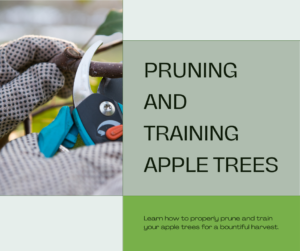
Pruning plays a critical role in ensuring the health and productivity of your apple trees. By removing unwanted or diseased branches, you can promote better air circulation and sunlight penetration, allowing your trees to thrive. Additionally, proper pruning encourages the growth of new shoots and improves fruit production.
Understanding the importance of pruning is key to maximizing your apple tree’s potential. Pruning helps maintain the tree’s shape and size, making it easier to manage and harvest. It also eliminates branches that could potentially break under the weight of fruit or during storms, reducing the risk of damage to both the tree and the crop.
There are various pruning and training techniques that you can employ to achieve the desired results for your apple trees. One common technique is the central leader system, which involves promoting a central, upright leader branch while removing competing branches. This technique ensures a strong framework and balanced growth.
Another technique is the open-center system, where the central leader is removed, and the tree is trained to have an open, bowl-like shape. This method allows for better light penetration and airflow, improving fruit quality and reducing the risk of fungal diseases.
“Pruning is like a sculptor shaping a masterpiece. With the right techniques, you can create a balanced and productive apple tree.”
Pruning Tips:
- Prune your apple trees during the dormant season, preferably in late winter or early spring, before new growth begins.
- Remove any dead, damaged, or diseased branches to prevent the spread of diseases.
- Thin out crowded branches to enhance air circulation and promote better fruit development.
- Prune with clean, sharp tools to make precise cuts and minimize damage to the tree.
- Regularly inspect and prune your trees throughout the growing season to maintain their shape and health.
By implementing proper pruning and training techniques, you can enhance the overall health and productivity of your apple trees. Take the time to understand the unique needs of your trees and tailor your pruning approach accordingly. With patience and care, you’ll be rewarded with bountiful harvests for years to come.
| Pruning Technique | Description |
|---|---|
| Central Leader System | Promotes a central, upright leader branch while removing competing branches. Creates a strong framework and balanced growth. |
| Open-Center System | Removes the central leader, training the tree to have an open, bowl-like shape. Allows for better light penetration and airflow, improving fruit quality and reducing the risk of fungal diseases. |
Pest and Disease Management
Effective pest and disease management is crucial for ensuring optimal apple production. Common pests and diseases can significantly impact the health and productivity of apple trees. By implementing proven methods for pest and disease control, you can safeguard your apple orchard and maximize your yields.
Common Pests
Apple trees are susceptible to a variety of pests that can cause damage to leaves, fruit, and overall tree health. Some common pests include:
- Codling moth: These insects lay their eggs in apple fruits, resulting in worm-infested apples.
- Apple maggot: These pests feed on the flesh of apples, causing internal damage.
- Aphids: These tiny insects suck sap from apple trees, leading to reduced vigor and deformities.
- Mites: Spider mites can cause discoloration and damage to apple leaves.
Implementing pest control measures is essential to protect your apple trees from these common pests. Regular monitoring, early detection, and appropriate actions are key to maintaining the health of your apple orchard.
Diseases Affecting Apple Production
Apple trees are also vulnerable to various diseases that can impact fruit quality and tree longevity. Some diseases affecting apple production include:
- Apple scab: A fungal disease that causes dark scabs on apple fruit and leaves.
- Fire blight: A bacterial disease that can cause wilting, darkening, and blackening of blossoms, shoots, and branches.
- Cedar apple rust: A fungal disease that causes orange spots on apple leaves and fruit.
- Powdery mildew: A fungal disease that results in a powdery white coating on apple leaves and fruit.
Implementing disease control measures is necessary to prevent the spread and severity of these diseases. Proper orchard sanitation, timely pruning, and the use of disease-resistant apple varieties are effective strategies for disease management.
Pest and Disease Control Methods
To effectively control pests and diseases in your apple orchard, consider the following methods:
- Integrated Pest Management (IPM): Implement an IPM program that combines various pest control strategies, including cultural, biological, and chemical methods, to minimize pest populations.
- Monitoring and Trapping: Regularly monitor your orchard for pest and disease activity and use traps to monitor pest populations.
- Biological Control: Introduce beneficial insects, nematodes, or mites that prey on pests as a natural control method.
- Chemical Control: If necessary, use targeted chemical insecticides or fungicides following label instructions to control pests and diseases.
Remember, proper identification of pests and diseases is essential for selecting the appropriate control methods. Consult with local agricultural extension services or experts to identify and address specific pest and disease issues in your region.
By effectively managing pests and diseases in your apple orchard, you can promote healthy tree growth, reduce crop losses, and ensure a successful apple harvest.
Common Pests and Diseases Affecting Apple Production
| Pests | Diseases |
|---|---|
| Codling moth | Apple scab |
| Apple maggot | Fire blight |
| Aphids | Cedar apple rust |
| Mites | Powdery mildew |
Implementing proper pest and disease control measures is critical for optimal apple production. By identifying and addressing common pests and diseases, you can protect your apple trees and ensure a healthy and bountiful harvest.
Irrigation and Fertilization Practices
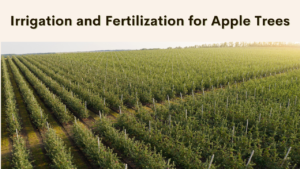
Proper irrigation and fertilization are crucial for meeting the nutritional requirements of your apple trees and maximizing their yield. By implementing optimal irrigation techniques and employing effective fertilization strategies, you can ensure that your apple trees receive the necessary nutrients to thrive.
When it comes to irrigation, it’s essential to strike a balance between providing enough water to meet the trees’ needs while avoiding waterlogging or drought stress. Consider the following irrigation techniques:
- Drip irrigation: This method involves delivering water directly to the root zone, minimizing wastage and optimizing nutrient uptake.
- Sprinkler irrigation: Suitable for larger orchards, this technique distributes water evenly over the trees using overhead sprinklers. However, it may be less efficient than drip irrigation.
Regular monitoring of soil moisture levels can help you determine the frequency and duration of irrigation. Pay attention to weather conditions and adjust irrigation accordingly to avoid overwatering or underwatering.
In terms of fertilization strategies, it’s crucial to provide the right balance of nutrients to support healthy growth and productivity. Consider conducting a soil analysis to assess the existing nutrient levels and tailor your fertilization plan accordingly.
While the specific nutritional requirements may vary depending on the apple tree variety and soil conditions, some common fertilization practices include:
- Organic matter: Incorporating organic amendments, such as compost or well-rotted manure, can enrich the soil and improve nutrient availability.
- Nitrogen: Apply nitrogen-based fertilizers at appropriate times during the growing season to promote vegetative growth and fruit development.
- Phosphorus and potassium: These essential macronutrients support root development, flowering, and overall tree vigor. Incorporate phosphorus and potassium fertilizers as needed based on soil analysis.
Remember to follow the recommended application rates and timing guidelines specified by your local agricultural extension or consult with a horticulture specialist to ensure you’re using the most suitable fertilization strategies for your apple trees.
The Importance of Nutrient Management
“Proper irrigation and fertilization practices play a vital role in achieving optimal apple production. By providing adequate water and essential nutrients, you can promote healthy tree growth, encourage high yields, and improve the overall quality of your apples.”
Harvesting and Storage Tips
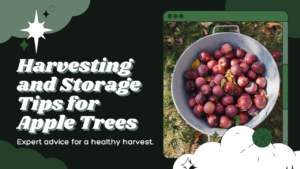
Knowing when to harvest and how to store your apples is crucial for maintaining their quality. Here are some essential tips and techniques to help you achieve the best results:
Determining Apple Maturity
Apple maturity refers to the stage when the apples have reached their peak flavor and texture. To determine apple maturity, consider the following factors:
- Color: Apples should have a uniform color specific to the variety.
- Firmness: Gently press an apple and ensure it is neither too hard nor too soft.
- Taste: Take a sample bite and assess if the apple has the desired sweetness and flavor.
Use these criteria to determine if your apples have reached the ideal maturity for harvesting.
Identifying the Ideal Harvest Time
The ideal harvest time varies depending on the apple variety and intended use. Here are some general guidelines:
| Apple Variety | Ideal Harvest Time |
|---|---|
| Gala | Mid to late September |
| Honeycrisp | Early to mid-October |
| Granny Smith | Mid to late October |
Remember to consult local agricultural experts or extension services for specific information regarding your region and apple variety.
Proper Storage and Post-Harvest Handling Techniques
After harvesting, follow these storage and handling techniques to maintain apple freshness:
- Avoid bruising: Handle apples gently, as bruised apples are more prone to decay.
- Cooling: Store apples in a cool environment, ideally around 32 to 40°F (0 to 4°C).
- Humidity control: Keep the humidity level between 90% and 95% to prevent apples from drying out.
- Avoid ethylene exposure: Apples produce ethylene gas, which can speed up the ripening process of other fruits. Store apples separately from other produce.
By following these guidelines, you can extend the shelf life of your apples and ensure they remain crisp and flavorful.
Implement these harvesting and storage tips to make the most of your apple harvest and enjoy fresh, delicious apples throughout the year.
FAQ
Q. How can I improve the production of my apple trees?
A. To boost the yield of your apple trees, you can implement various techniques such as pruning, proper irrigation, and pest control. These practices help ensure that your apple trees thrive and produce abundant fruits.
Q. What factors can affect apple production?
A. Several factors can influence apple production, including weather conditions, disease and pest infestations, soil quality, and the availability of proper nutrients. It’s important to address these factors to optimize the productivity of your apple trees.
Q. What are the stages involved in the apple production process?
A. The apple production process typically involves several stages, including soil preparation, planting, pruning and training, pest and disease management, irrigation and fertilization, harvesting, and post-harvest storage. Each stage plays a crucial role in ensuring successful apple production.
Q. How can I identify suitable soil conditions for apple trees?
A. To identify suitable soil conditions for apple trees, consider factors such as soil pH, drainage capabilities, fertility, and organic matter content. Conducting a soil test can provide valuable insights into the composition of your soil and help determine if it is suitable for apple tree cultivation.
Q. What are the different planting methods and optimal timing for apple trees?
A. There are various planting methods for apple trees, including bare-root planting, container planting, and grafting. The optimal timing for planting apple trees is during the dormant season, usually in late winter or early spring. This allows the trees to establish strong root systems before active growth begins.
Q. Why is pruning important for apple trees?
A. Pruning is essential for apple trees as it helps maintain their overall health, shape, and productivity. It promotes better air circulation, sunlight penetration, and the development of strong branching structures. Pruning also helps control tree size and removes diseased or damaged branches.
Q. What are the different pruning and training techniques for apple trees?
A. Some common pruning and training techniques for apple trees include central leader training, open center training, and espalier training. Each method has its advantages and is used to achieve specific tree shapes and maximize sunlight exposure.
Q. What are some common pests and diseases that affect apple production?
A. Apple trees can be susceptible to pests like apple maggots, codling moths, and aphids, as well as diseases such as apple scab, powdery mildew, and fire blight. Implementing proper pest and disease management practices is crucial to protect your apple trees from damage and ensure optimal production.
Q. What are effective methods for pest and disease control in apple production?
A. Integrated Pest Management (IPM) techniques are widely used in apple production to control pests and diseases. These methods include cultural practices like regular sanitation, introducing beneficial organisms, and judicious use of pesticides. Regular monitoring and early intervention also play a key role in effective pest and disease control.
Q. What are optimal irrigation techniques for apple trees?
A. Apple trees require regular and sufficient water for proper growth and productivity. Drip irrigation and sprinkler irrigation are common methods used to provide water directly to the tree’s root zones. Proper scheduling and monitoring of irrigation, based on weather conditions and soil moisture levels, are crucial for optimal water management.
Q. What are the nutritional requirements and fertilization strategies for maximum apple yield?
A. Apple trees require a balanced supply of essential nutrients for optimal growth and fruit production. Conducting a soil test can help determine the specific nutritional needs of your orchard. Fertilizer application should be based on the test results, using organic or synthetic fertilizers to provide the necessary nutrients in the right amounts.
Q. How do I determine the maturity and harvest time for apples?
A. The maturity and harvest time for apples can be determined by monitoring factors such as fruit color, firmness, sugar content (Brix level), and seed color. Different apple varieties have specific indicators of maturity, and it’s crucial to harvest them at the right time to ensure the best quality and flavor.
Q. What are the proper storage and post-harvest handling techniques for apples?
A. To maintain the freshness, flavor, and quality of harvested apples, it’s essential to store them under proper conditions. This includes controlling temperature and humidity levels, sorting and removing damaged fruits, and storing apples in well-ventilated containers. Additionally, post-harvest techniques such as washing, waxing, and packaging can help extend the shelf life of apples.
Conclusion
In conclusion, improving apple production involves implementing a variety of techniques that promote optimal tree health and yield. Throughout this article, we have discussed key strategies for enhancing apple production.
By focusing on soil preparation and planting techniques, such as identifying suitable soil conditions and understanding optimal timing, you can lay a strong foundation for your apple trees to thrive. Additionally, incorporating proper pruning and training methods ensures optimal tree structure and fruit production.
Effective pest and disease management, along with appropriate irrigation and fertilization practices, play crucial roles in maintaining healthy apple trees and maximizing yield. Lastly, understanding the importance of proper harvesting and storage techniques helps preserve the quality of your apples.
As the industry continues to progress, future trends and advancements in apple production offer exciting prospects. These may include the development of new technology for monitoring and managing orchards, as well as the introduction of disease-resistant apple varieties. By staying informed and adapting to these advancements, you can further optimize your apple production and stay ahead in the industry.


